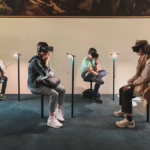Innovation is the driving force behind progress and change in the modern world. It is the process of creating new ideas, products, or methods that bring about significant improvements in various aspects of life. The power of innovation lies in its ability to transform abstract concepts into tangible, real-world impact.
Whether it’s a groundbreaking technological advancement, a revolutionary business model, or a novel approach to solving social issues, innovation has the potential to reshape industries, improve quality of life, and drive economic growth. Innovation is not limited to any specific field or industry; it can be found in technology, healthcare, education, agriculture, and beyond. For example, the development of renewable energy technologies has revolutionized the way we produce and consume energy, leading to a more sustainable and environmentally friendly future.
Similarly, innovations in healthcare, such as precision medicine and medical imaging technologies, have significantly improved patient outcomes and quality of care. The power of innovation lies in its ability to address complex challenges, create value, and drive positive change on a global scale.
Key Takeaways
- Innovation leaders are driving real-world impact by transforming ideas into impactful innovations.
- The journey of turning ideas into impactful innovations involves overcoming challenges and implementing strategies and tactics.
- Innovation leaders are creating a lasting impact and shaping the future of innovation.
- Insights from innovation leaders provide valuable lessons on making a difference and driving change.
- Today’s innovation leaders are shaping tomorrow’s impact through their innovative ideas and strategies.
Meet the Innovation Leaders: Driving Change and Making a Difference
Innovation leaders are individuals or organizations at the forefront of driving change and making a difference through their groundbreaking ideas and initiatives. These leaders possess a unique combination of vision, creativity, and determination to turn their innovative concepts into reality. They are often pioneers in their respective fields, pushing the boundaries of what is possible and inspiring others to follow suit.
Innovation leaders can be found in various sectors, including technology, business, science, and social entrepreneurship. One notable example of an innovation leader is Elon Musk, the CEO of SpaceX and Tesla. Musk’s ambitious vision for space exploration and sustainable energy has led to the development of revolutionary technologies such as reusable rockets and electric vehicles.
His relentless pursuit of innovation has not only transformed industries but has also sparked a global conversation about the future of transportation and space exploration. Another example is Dr. Anthony Fauci, a leading immunologist whose innovative research and public health advocacy have been instrumental in combating infectious diseases and shaping global health policies.
These innovation leaders serve as role models for aspiring changemakers and demonstrate the profound impact that visionary leadership can have on society.
From Concept to Creation: The Journey of Turning Ideas into Impactful Innovations
The journey from concept to creation is a critical phase in the innovation process, requiring careful planning, resource allocation, and execution. It begins with the identification of a problem or opportunity that sparks the generation of new ideas. This ideation phase involves brainstorming, research, and experimentation to explore potential solutions and refine concepts.
Once a promising idea takes shape, the next step is to translate it into a tangible innovation through prototyping, testing, and iteration. For example, the development of the iPhone by Apple involved years of research and development to transform the concept of a touchscreen smartphone into a game-changing product that revolutionized the mobile industry. Similarly, the creation of the polio vaccine by Dr.
Jonas Salk required extensive laboratory work and clinical trials to turn a scientific breakthrough into a life-saving medical intervention. The journey from concept to creation is often marked by setbacks, challenges, and moments of uncertainty, but successful innovation leaders persevere through these obstacles to bring their ideas to fruition.
Overcoming Challenges: The Strategies and Tactics of Innovation Leaders
Innovation leaders face a myriad of challenges as they navigate the complex landscape of turning ideas into impactful innovations. These challenges may include technological barriers, regulatory hurdles, market competition, funding constraints, and resistance to change. To overcome these obstacles, innovation leaders employ various strategies and tactics to drive progress and achieve their goals.
One common approach is to foster a culture of experimentation and risk-taking within their organizations, encouraging team members to explore unconventional ideas and embrace failure as a learning opportunity. Additionally, collaboration with external partners, such as research institutions, industry experts, and government agencies, can provide access to resources and expertise that are essential for advancing innovative projects. Furthermore, effective communication and stakeholder engagement are crucial for gaining support and buy-in for new initiatives, especially when challenging the status quo or introducing disruptive innovations.
The Ripple Effect: How Innovation Leaders Are Creating Lasting Impact
The impact of innovation leaders extends far beyond the initial implementation of their ideas; it creates a ripple effect that influences industries, communities, and future generations. By introducing new technologies, business models, or social interventions, innovation leaders can catalyze systemic change that permeates through various levels of society. For instance, the introduction of ride-sharing platforms like Uber and Lyft has not only transformed the transportation industry but has also reshaped urban mobility patterns and consumer behavior.
Moreover, innovations in sustainable agriculture practices have the potential to address food security challenges, mitigate environmental degradation, and improve livelihoods for farmers around the world. The ripple effect of innovation is characterized by its ability to inspire emulation and adaptation by others, leading to a cascading impact that transcends individual efforts and contributes to broader societal progress.
Lessons Learned: Insights from Innovation Leaders on Making a Difference
Innovation leaders have valuable insights and lessons learned from their experiences in driving change and making a difference. One key lesson is the importance of resilience and perseverance in the face of adversity. The path to impactful innovation is often fraught with uncertainty and setbacks, requiring leaders to maintain unwavering determination and adaptability.
Another lesson is the significance of empathy and human-centered design in creating innovations that truly address societal needs and improve people’s lives. By understanding the perspectives and experiences of end-users, innovation leaders can develop solutions that are relevant, accessible, and impactful. Furthermore, collaboration and cross-disciplinary thinking are essential for tackling complex challenges that require diverse expertise and perspectives.
Innovation leaders emphasize the value of building diverse teams and fostering an inclusive environment that encourages creativity and innovation from all members.
The Future of Innovation: How Today’s Leaders Are Shaping Tomorrow’s Impact
As today’s innovation leaders continue to push boundaries and drive change, they are shaping the future landscape of innovation and its impact on society. Emerging trends such as artificial intelligence, biotechnology, clean energy technologies, and digital transformation are poised to redefine industries and create new opportunities for addressing global challenges. Moreover, the increasing emphasis on sustainability, social impact, and ethical considerations in innovation reflects a growing awareness of the interconnectedness of global issues and the need for responsible innovation practices.
Today’s leaders are paving the way for a future where innovation is not only synonymous with progress but also with inclusivity, sustainability, and positive societal impact. In conclusion, innovation leaders play a pivotal role in transforming ideas into real-world impact through their vision, determination, and strategic approach to driving change. Their contributions have far-reaching implications that extend beyond individual initiatives, shaping industries, communities, and future generations. As they continue to navigate challenges, learn from their experiences, and shape the future of innovation, these leaders are instrumental in creating a more dynamic and impactful world for us all.



